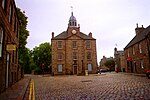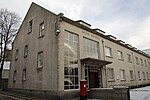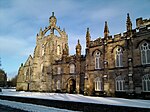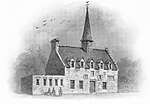Sir Duncan Rice Library

The Sir Duncan Rice Library is the main academic library for the University of Aberdeen. It was designed by Schmidt Hammer Lassen Architects and completed in 2011. It is named after Duncan Rice, a previous Principal of the university. The cube-shaped building can be seen prominently from the entire campus and much of the city. It is a seven-storey tower, clad in zebra-like jagged stripes of white and clear glass. The building has a floorspace of 15,500 square metres. It houses several of the University's historic collections, including more than a quarter of a million ancient and priceless books and manuscripts that have been collected over five centuries since the University's foundation. There is also public exhibition space. The library replaced the smaller Queen Mother Library as the university's main library.
Excerpt from the Wikipedia article Sir Duncan Rice Library (License: CC BY-SA 3.0, Authors, Images).Sir Duncan Rice Library
Wrights' and Coopers' Place, Aberdeen City Old Aberdeen
Geographical coordinates (GPS) Address Website Nearby Places Show on map
Geographical coordinates (GPS)
| Latitude | Longitude |
|---|---|
| N 57.164984 ° | E -2.105614 ° |
Address
University of Aberdeen (Aberdeen University;University of Aberdeen - Old Aberdeen Campus;University of Aberdeen - King's College)
Wrights' and Coopers' Place
AB24 3EZ Aberdeen City, Old Aberdeen
Scotland, United Kingdom
Open on Google Maps









